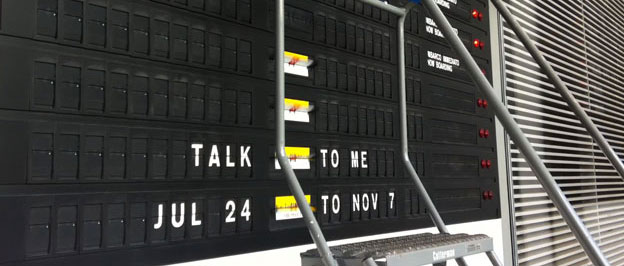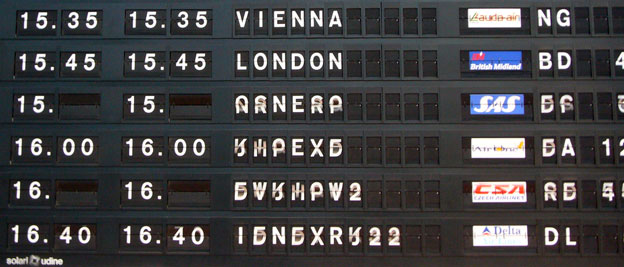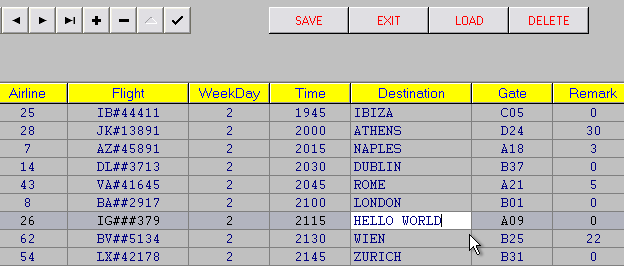
Hacked Solari di Udine flight board
One of the aspects I like most about working in the Digital Media department is building exhibition subsites, the online complements to our gallery exhibitions. We don’t build all our subsites in-house; many are handled by outside design firms. In the case of Talk to Me (on view through November 7), we left it in the capable hands of Stamen Design (who also built the excellent companion site to Andy Warhol: Motion Pictures). It should come as no surprise that Talk to Me is very near and dear to our hearts here in Digital Media, so we were keen on thinking of other ways we could offer our support. We met up and discussed other ways to promote the exhibition, while staying true to the theme of objects that communicate.
Shannon Darrough had an idea to create a kind of “easter egg” in the Museum with the Solari di Udine flight board, on display in the third-floor Architecture and Design galleries. He suggested that we temporarily replace its usual flight information, a snapshot from its original schedule used at Milan’s Malpensa Airport. By intermittently inserting new messages we could guide visitors to Talk to Me, also on view on the third floor. Paola Antonelli, the curator of Talk to Me, liked the idea—it seemed very much in the spirit of the exhibition. Plus it sounded like a fun project, so I volunteered to figure out how to make it work.

Solari di Udine in motion
I sat with the board for a while observing its behavior. Two minutes before departure time a “now boarding” message flips into place next to the top-most flight, accompanied by red flashing lights. A minute later the board flap-flap-flaps into its new configuration; the top five rows first, then the bottom four. Once the board has finished reconfiguring itself, the entry for the departing flight disappears from the top and a new one appears at the bottom. In five- to 15-minute intervals, the schedule migrates upward throughout the day.
Pamela Popeson, the A&D Department Preparator, showed me the custom software she uses to operate the board. It’s kind of a thin wrapper around a spreadsheet with columns for departure time, flight number, arrival city, and gate number. I installed a copy of the software and started exploring how it works. Dina Brunstein, who sits next to me, pointed out a plain text file called flights.dat that line-for-line matched the information in the spreadsheet. Huzzah! By simply modifying this file I could easily control and automate what information makes it onto the board. I’d just have to introduce a pattern of strange city names, oddly pronounceable flight numbers, and nonexistent airport gates.

Solari di Udine's custom MessageManager software
In total there are nine rows of 11 flippers, each supporting letters, numbers, dots, and slashes. The task of repurposing this towering undocumented hardware was reduced to a very manageable software problem. I wrote some PHP code to parse the text file into memory. Then I added a reverse process to save my changes in memory to a new flights.dat file. Building on these I wrote a Web-based simulator board so I could easily try out different approaches for displaying messages, and I developed a rudimentary typographic system. After a few iterations and a lot of testing, I arrived at a stable solution that doesn’t require any significant changes to the board’s operation.
Last week I exported a finalized flight schedule and clicked the button to load it onto the board. And now each day just before 11:00 a.m. and 1:00, 3:00, and 5:00 p.m., a secret Talk to Me promotion flips into view.

